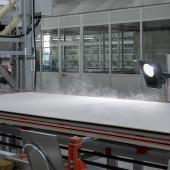Growth forecasts for the Indian tile industry

Production and exports will continue to grow. The new challenge comes from the introduction of 42.9% antidumping duties on Indian tiles in the Gulf States.
“Indian tile production [1.145 billion sq.m in 2018, +6%] will continue to grow at an estimated rate of +8% in 2019 and +13% in 2020”. This forecast was announced by Prem Narayan Trivedi, chairman of H&R Johnson India and past president of Indian Council of Ceramic Tiles & Sanitaryware at the conference “The Future of Ceramics” (Modena, Italy, 11 November 2019).
According to the Indian manufacturer, the Indian ceramic tile industry will receive a boost from the tax reform and from the introduction of antidumping duties on Chinese tile imports. On the other hand, India’s manufacturing operations will be hindered by the volatility in the price of natural gas, which accounts for between 15% and 30% of production costs, and ever higher transportation costs.
Exports are also expected to continue the upward trend that has enabled India to double its volumes in 4 years [274 million sq.m in 2018, +20%] and become the world’s fourth largest exporter country in 2018 (probably the third in 2019) with exports amounting to 24% of its total output. This growth has partly been driven by the ability to win market shares previously held by China in countries and regions that introduced antidumping duties on Chinese ceramic tiles (EU, Brazil, Taiwan, Chile, Vietnam and South Korea, amongst others). This in turn has been made possible by the continuous investments in technology made in the last five years in the Morbi district with the aim of modernising factories, increasing production capacity and improving product quality, including that of the most innovative products such as large slabs, while maintaining the lowest production costs of any exporter country.
However, the tariff barriers that have buoyed Indian exports in some markets will effectively exclude Indian tiles from the Gulf states (Bahrein, Kuwait, Oman, Qatar, Saudi Arabia and UAE). In November, the Cooperation Council for the Arab States of the Gulf (CCASG) expressed its support for the introduction of antidumping duties on tile imports from India, China and Spain, choosing to impose the highest tariff rate (42.9%) on Indian tiles compared to the 24% applied to Chinese products.
Moreover, according to Trivedi, it is highly likely that average export prices (currently amongst the lowest in the world at 3 euros/sq.m) will tend to increase. Over the next 3-5 years, the less organised companies in the Morbi district will see a sharp rise in production costs as they are forced to comply with more stringent anti-pollution and workplace regulations and also face costs deriving from the tax reform.
Did you find this article useful?
Join the CWW community to receive the most important news from the global ceramic industry every two weeks






















